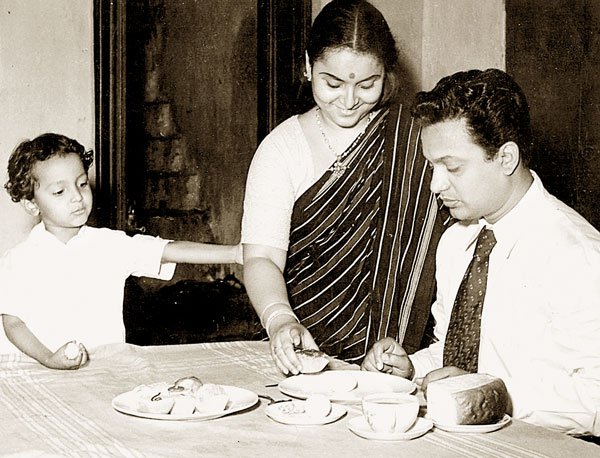| Famous Bengali Movie Actor Uttam Kumar with his Family - 1965 |
| Gold and Silver Wire and Thread Drawers at Work - 1873 Photographer: Shivashanker Narayen The tinsel wires are made of silver, or silver coated with gold leaf, and made into a bar, which is then forced through a series of holes on a steel plate to obtain increasingly fine-gauged lengths. Traditionally the wire was then wound onto a reel, as seen in the photograph, attached at the other end to a jantar, another steel plate, which allowed for further refining of the gauge. Wires no thicker than a hair were obtained this way. A tola (180 grains of metal) usually produced 600 to 1,200 yards of wire. This product is used, sometimes together with silk, in a wide range of articles and garments. Examples of all the following were sent to the Vienna exhibition: turbans, saris, dresses, shoes, fringing, gold and silver lace, shawls, rugs and tablecloths. It was held that metal threads from India were less likely to tarnish than similar products from other sources. Source: British Library  |
| Indian Chatty (Pottery) Shop - 1873 |
| Group of pupils of the Bhagwandas Purshottum Girls' School, Bombay (Mumbai) - 1873 |
| Potter at work at His Wheel and a Young Girl is Watching - Pune (Poona), Maharashtra - 1873 |
| Photograph of a Class in the Parsi Virbaiji School at Karachi in Sind - 1873 |
| Gold and Silver Tape Beater at Work - 1873 Photographer: Shivashanker Narayen The worker here is beating gold and silver wires (tinsel) into flattened tape on a low anvil with a small hammer. The work is carried out extremely quickly and without missing any sections of the wire drawn off the holding reel. The tapes are used as decoration on a wide range of garments and may be sewn onto or threaded through woven fabrics. It was held that metal threads from India were less likely to tarnish than similar products from other sources. Source: British Library |
| Public works including the Manora Breakwater and the River Son canal system - 1873 An annicut, or weir was built on the Son between 1869 and 1875 by constructing a mass of rubble stone masonry founded on shallow wells. It is 12,469 feet long and consists of scouring sluices positioned at each flank which are fitted with gates which can be opened or closed at any state of the river other than high flood. Through these the gates the level of water in the pool above the weir can be kept at the height required to supply the canals that branch off from the dam and traverse the plains. The Son canal system became one of the most important irrigation systems and provided water for a large tract and increased cultivation. Source: British Library  |
| Photograph of a Girls' School at Bombay (Mumbai) in Maharashtra - 1873 |
| Carpet Weavers in Karachi Jail in Sindh - 1873 Photographer: Michie and Company Source: British Library |
| Group of Sonars (Goldsmith Caste) at Work at Cuttack in Orissa - 1873 |




















No comments:
Post a Comment